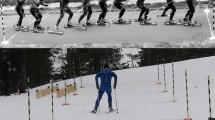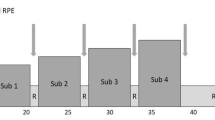Abstract
Modern ski-treadmills allow cross-country skiers, biathletes and ski-orienteers to test their physical fitness in a laboratory environment whilst performing classical and freestyle (skating) techniques on roller skis. For elite athletes, the differences in performance between test occasions are quite small, thus emphasising the importance of knowing the roller skis’ rolling resistance in order to allow the correct comparison between the results of different test occasions. In this study, the roller skis’ rolling resistance was measured on the ski-treadmill’s surface using a roller ski rolling resistance measurement system specially produced for this purpose. The study investigated the influence of significant changes in rolling resistance on physiological variables. The results showed that during submaximal exercise, power, oxygen uptake, heart rate and blood lactate were significantly changed by different rolling resistances, while there were no significant or only small changes to cycle rate, cycle length and ratings of perceived exertion. Incremental maximal tests showed that time to exhaustion was significantly changed by different rolling resistances and this occurred without significant changes in maximal power, maximal oxygen uptake, maximal heart rate and blood lactate, and that the influence on ratings of perceived exertion were insignificant or small.










Similar content being viewed by others

References
Calbet JA, Holmberg HC, Rosdahl H, van Hall G, Jensen-Urstad M, Saltin B (2005) Why do arms extract less oxygen than legs during exercise? Am J Physiol Regul Integr Comp Physiol 289:1448–1458
Holmberg HC, Lindinger S, Stoggl T, Eitzlmair E, Muller E (2005) Biomechanical analysis of double poling in elite cross-country skiers. Med Sci Sports Exerc 37:807–818
Rundell KW (1995) Treadmill roller ski test predicts biathlon roller ski race results of elite U.S. biathlon women. Med Sci Sports Exerc 27:1677–1685
Hoffman DM, Clifford SP, Bota B, Mandli M, Jones MG (1990) Influence of body mass on energy cost of roller skiing. Int J Sport Biomech 6:374–385
Hoffman DM, Clifford SP, Watts BP, O’Hagan PK, Mittelstadt WS (1995) Delta efficiency of uphill roller skiing with the double pole and diagonal stride techniques. Can J Appl Physiol 20:465–479
Millet YG, Hoffman DM, Candau BR, Buckwalter BJ, Clifford SP (1998) Effect of rolling resistance on poling forces and metabolic demands of roller skiing. Med Sci Sports Exerc 30:755–762
Ainegren M, Carlsson P, Tinnsten M (2008) Rolling resistance for treadmill roller skiing. Sports Eng 11:23–29
Hoffman DM, Clifford SP, Snyder SP, O’Hagan PK, Mittelstadt WS, Roberts MM, Drummond AH, Gaskill ES (1998) Physiological effects of technique and rolling resistance in uphill roller skiing. Med Sci Sports Exerc 30:311–317
Padilla S, Mujika I, Orbananos J, Angulo F (2000) Exercise intensity during competition time trials in professional road cycling. Med Sci Sports Exerc 32:850–856
Jensen K, Jörgensen S, Johansen L (2002) A metabolic cart for measurement of oxygen uptake during human exercise using inspiratory flow rate. Eur J Appl Physiol 87:202–206
Borg G (1998) Borg’s perceived exertion and pain scales. Human Kinetics, Champaign
Gore CJ (2000) Physiological tests for elite athletes. Australian Sports Commission. Human Kinetics, Champaign, pp 50–65
Åstrand PO, Rodahl K (1986) Textbook of work physiology. Physiological bases of exercise. McGraw-Hill Book Company, New York
Allen DG, Lamb GD, Westerblad H (2008) Skeletal muscle fatigue: cellular mechanisms. Physiol Rev 88:287–332
McArdle WD, Katch FI, Katch VL (2001) Exercise physiology. Lippincott Williams & Wilkins, Philadelphia
Roffey DM, Byrne NM, Hills AP (2007) Effect of stage duration on physiological variables commonly used to determine maximum aerobic performance during cycle ergometri. J Sports Sci 25:1325–1335
Zhang YY, Johnson M, Chow N, Wasserman K (1991) Effect of exercise testing protocol on parameters of aerobic function. Med Sci Sports Exerc 23:625–630
Acknowledgements
The authors would like to thank Professor Bengt Saltin (Copenhagen Muscle Research Centre and Mid Sweden University) for his support during the development of testing methods. Many thanks also go to the athletes who participated in the study. The authors would also like to thank Glenn Björklund (Mid Sweden University) and Robin Johansson (Swedish X-country Ski Association) for their goodwill in warming up the roller skis in the freestyle part of the study. Finally, thanks are also due to the European Union’s regional development fund, which provided financial support for the study.
Author information
Authors and Affiliations
Corresponding author
Appendix
Appendix
Results from physiological tests using freestyle (n = 10) and classical (n = 10) techniques in two submaximal workloads and an incremental maximal test. T1 and T2 represent test occasions one and two, with the same pair of roller skis, and T3 is the test occasion with a pair of roller skis with a significantly lower (freestyle, 47%) and higher (classical, 50%) rolling resistance (Mean, SD). T1 vs T2, T2 vs T3 and T1 vs T3 represent the differences (d) and statistics (p) between the three test occasions.
Rights and permissions
About this article
Cite this article
Ainegren, M., Carlsson, P. & Tinnsten, M. Roller ski rolling resistance and its effects on elite athletes’ performance. Sports Eng 11, 143–157 (2009). https://doi.org/10.1007/s12283-009-0016-5
Published:
Issue Date:
DOI: https://doi.org/10.1007/s12283-009-0016-5



